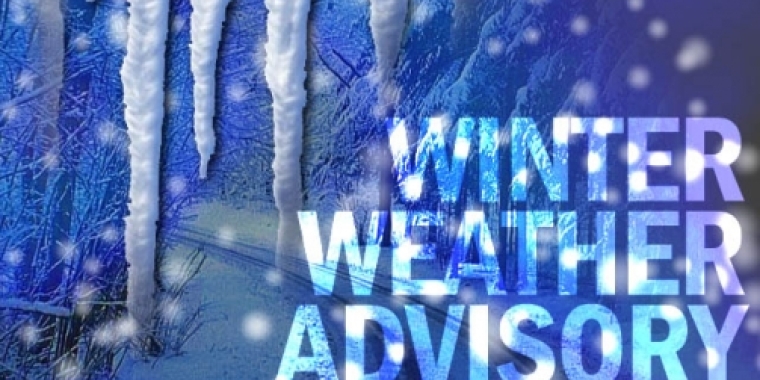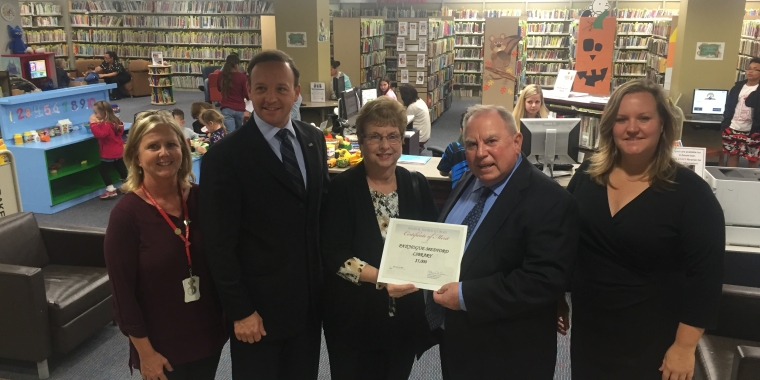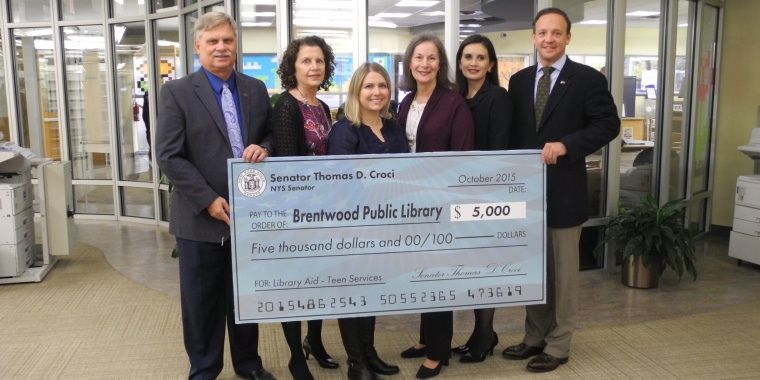
Winter Weather Advisory - Storm Resources & Information
Senator Thomas Croci
January 19, 2016

It is important that every year our residents are prepared for emergencies, including severe winter weather, and have access to the resources and information to keep your family safe.
The information provided below can be helpful over the coming months and has been incorporated into this section of my website. You will also find specific tips to provide you and your family with the information you need if you travel, shovel or simply stay indoors during winter weather.
I hope you find this information useful and please be safe this winter season.
Sincerely,
Thomas Croci
******************************************
PSEG Long Island Report An Outage Page
For a power emergency or downed line, please call PSEG Long Island's Emergency Hotline Number is 800-490-0075 or 631-755-6900
PSEG Long Island Services for Special Customers Page
Newsday's School and Facility Closing Page
511NY is New York State's official traffic and travel info source. Whether you drive or take public transit, click below or simply dial 511 on your phone for up to date information on traffic and transit conditions in New York State.
Motorists who need to check conditions can access winter weather travel updates at https://www.nysdot.gov/wta. Real-time travel reports can also be accessed by phone by dialing 511 or online at www.511ny.org.
American Red Cross Winter Storm Safety Tips
American Red Cross Winter Safety Tips For Pets
American Red Cross Winter Storm Safety Preparedness
Suffolk County S.P.C.A. Animal Safety Tips
Cold Weather Pet Safety Tips from the American Veterinary Medical Association
Pet Friendly Shelters in Suffolk County
New York State Aware Prepare Website
New York State Division of Homeland Security and Emergency Services Winter Safety Tips
DHSES Emergency Information Handbook
Suffolk County Emergency Preparedness Web Site
Money Saving Tips from the Weather Channel
Tips to Protect Your Home During Winter from the Weather Channel
Tips To Prevent Frozen Pipes from the Weather Channel
Tips To Prepare Home And Auto from Nationwide
New York State Emergency Management Winter Safety Tips
Families should be prepared for all hazards that affect their area and themselves. Follow these basic steps to develop a family disaster plan:
- Learn your community’s warning signals.
- Meet with your family to create a plan. Pick two places to meet: a spot outside your home for an emergency such as fire, and a place away from your neighborhood in case you cannot return home (a real possibility during the day when adults are at work and children are at school). Choose an out-of-area friend as your family check-in contact for everyone to call if the family becomes separated.
- Implement your plan. Post emergency telephone numbers by the phones. Install safety features in your house such as smoke detectors and fire extinguishers. Inspect your home for potential hazards and correct them. Have your family learn basic safety and first aid measures. Make sure everyone knows how and when to call 9-1-1 or your local emergency medical services phone number. Have disaster supplies on hand.
Use Caution If Travel Is Necessary:
It is important for motorists on all roads to note that snowplows travel at speeds up to 35 miles per hour, which in many cases is lower than the posted speed limit, to ensure that salt being dispersed stays in the driving lanes and does not scatter off the roadways. Oftentimes on interstate highways, snowplows will operate side by side, as this is the most efficient and safe way to clear several lanes at one time.
Motorists and pedestrians should also keep in mind that snowplow drivers have limited lines of sight, and the size and weight of snowplows can make it very difficult to maneuver and stop quickly. Snow blowing from behind the plow can severely reduce visibility or cause whiteout conditions. Motorists should not attempt to pass snowplows or follow too closely. The safest place for motorists to drive is well behind the snowplows where the roadway is clear and salted.
Some of the most important tips for safe winter driving include:
- Never follow a snowplow too closely or attempt to pass one. Remember that the highway ahead of the plow is usually snow-covered;
- Adjust speed for road conditions and maintain a safe distance from other vehicles;
- Schedule extra time for winter travel and be patient during ice and snow removal operations;
- Assume that bridge surfaces are slippery, as they freeze more quickly than road surfaces;
- Be wary of black ice, which can be difficult to see but makes conditions slippery when pavement temperatures are below freezing;
- Have a cell phone handy, if possible, but do not text while driving; distracted driving is illegal and becomes even more dangerous during storm events;
- Never venture from your vehicle if snowbound;
- Equip your car with emergency supplies including sand, shovel, flares, booster cables, rope, ice scraper, portable radio, flashlight, blankets and extra warm clothes;
- Inform a responsible person of your destination, intended route, and estimated time of arrival; and
- Keep calm and do not panic in case of a vehicle breakdown, accident, or if you become snowbound.
Motorists should also include the following emergency items in their vehicles:
- Flashlight with extra batteries
- Charged cell phone and automobile charger
- Basic first-aid kit
- Blankets or sleeping bags
- Extra clothes, including rain gear, boots, mittens, and socks
- Windshield scraper and brush
- Fire extinguisher
- Shovel
- Sand, road salt and/or cat litter for traction
- Tire chains or traction mats
- Basic tool kit, including pliers, wrench, and screwdriver
- Tow rope
- Battery jumper cables
- Road flares/reflectors
- Brightly colored cloth (to use as a flag)
- Road maps
Heavy exertion, such as shoveling snow, clearing debris, or pushing a car, can increase the risk of a heart attack. To avoid problems:
- Stay warm, dress warm and SLOW DOWN when working outdoors.
- Take frequent rests to avoid over exertion.
- If you feel chest pain, shortness of breath, or pain in the jaw or radiating down the arm --STOP and seek help immediately.
If You Lose Power:
- First, call your utility to determine area repair schedules.
- Turn off or unplug lights and appliances to prevent a circuit overload when service is restored. Leave one light on to indicate when power has been restored.
- If heat goes out during a winter storm, keep warm by closing off rooms you do not need.
Other Home Safety Tips:
- When removing snow and ice from driveways and sidewalks, stay clear of electric and natural gas meters to avoid damaging them, inadvertently disrupting service or putting yourself in danger. Snow and ice can damage electric and natural gas meters, natural gas pipes and natural gas regulators, so never bury any of this equipment when shoveling, using a snowblower or plowing.
- When removing snow or ice from a roof, never let it fall on electric or natural gas meters or related equipment.
- Natural gas appliance chimneys and vents should be kept free of snow and ice to prevent the build-up of potentially-deadly carbon monoxide.
- Be prepared if you smell natural gas. If you smell that distinctive sulfur-like odor – like the smell of rotten eggs – get up, get out and call your utility immediately from a cell phone or neighbor’s phone.
For more winter safety tips, visit the NYS Division of Homeland Security & Emergency Services at http://www.dhses.ny.gov/oem/safety-info/publicsafety/winter.cfm.
Home Emergency Supplies:
Winter has arrived and you should stockpile the following supplies in the event a winter storm or power outage prevents you from leaving your home.
- Flashlights and extra batteries
- Battery-operated radio and extra batteries
- Emergency non-perishable foods that do not require refrigeration
- Non-electric can opener
- Bottled water
- One week supply of essential medicines
- Extra blankets and sleeping bags
- First aid kit and manual
- Fire extinguisher
- Emergency heating equipment, used properly
Winterize Your Home:
Take the time now to get your home ready for the winter season by following these tips:
- Have your heating system checked by a professional annually. This will ensure that your system is working safely and efficiently which, in turn, will save you money. If you heat by wood, clean your fireplace or stove. Have your chimney flue checked for any buildup of creosote and then cleaned to lessen the risk of fire.
- Make sure your home is properly insulated. If necessary, insulate walls and attic. This will help you to conserve energy and reduce your homes power demands for heat.
- Caulk and weather-strip doors and windowsills to keep cold air out.
- Install storm windows or cover windows with plastic from the inside. This will provide an extra layer of insulation, keeping more cold air out.
- Inspect and flush your water heater.
- Clean gutters. Leaves and other debris will hamper drainage.
- Replace batteries of smoke, heat and carbon monoxide detectors. If you did not do it when you set the clocks back, do it now.
To keep pipes from freezing:
- Wrap pipes in insulation or layers of old newspapers
- Cover the newspapers with plastic to keep out moisture
- Let faucets drip a little to avoid freezing
- Know how to shut off water valves
Staying Warm Indoors:
If your heat goes out during a winter storm, you can keep warm by closing off rooms you do not need.
- Use only safe sources of alternative heat such as a fireplace, small well-vented wood or coal stove or portable space heaters. Always follow manufacturer’s instructions.
- Dress in layers of lightweight clothing and wear a cap.
- Eat well-balanced meals.
Losing your heat when winters winds are howling is not pleasant. However, by following these simple tips, you will weather the storm more comfortably.
Protecting Water Pipes:
To prevent the mess and aggravation of frozen water pipes, protect your home, apartment or business by following the simple steps below.
Before Cold Weather:
- Locate and insulate pipes most susceptible to freezing, typically those near outer walls, in crawl spaces or in the attic.
- Wrap pipes with heat tape (UL approved).
- Seal any leaks that allow cold air inside where pipes are located.
- Disconnect garden hoses and shut off and drain water from pipes leading to outside faucets. This reduces the chance of freezing in the short span of pipe just inside the house.
When It's Cold:
- Let hot and cold water trickle at night from a faucet on an outside wall.
- Open cabinet doors to allow more heat to get to un-insulated pipes under a sink or appliance near an outer wall.
- Make sure heat is left on and set no lower than 55 degrees.
- If you plan to be away: (1) Have someone check your house daily to make sure the heat is still on to prevent freezing, or (2) drain and shut off the water system (except indoor sprinkler systems).
If Pipes Freeze:
- Make sure you and your family knows how to shut off the water, in case pipes burst. Stopping the water flow minimize the damage to your home. Call a plumber and contact your insurance agent.
- Never try to thaw a pipe with an open flame or torch.
- Always be careful of the potential for electric shock in and around standing water.
If The Lights Go Out:
If you lose electrical service during the winter, follow these tips:
- Call your utility first to determine area repair schedules. Turn off or unplug lights and appliances to prevent a circuit overload when service is restored. Leave one light on to indicate power has been restored.
- To help prevent freezing pipes, turn on faucets slightly. Running water will not freeze as quickly.
- Protect yourself from carbon monoxide poisoning:
- DO NOT operate generators indoors; the motor emits deadly carbon monoxide gas.
- DO NOT use charcoal to cook indoors. It, too, can cause a buildup of carbon monoxide gas.
- DO NOT use your gas oven to heat your home -- prolonged use of an open oven in a closed house can create carbon monoxide gas.
- Make sure fuel space heaters are used with proper ventilation.
- Keep refrigerator and freezer doors closed as much as possible to help reduce food spoilage.
Generator Safety:
Electric generators can provide you with piece of mind and convenience when you are faced with a temporary loss of electric service.
Follow these safety guidelines when operating a generator:
- Before installing a generator, be sure to properly disconnect from your utility electrical service. If possible, have your generator installed by a qualified electrician.
- Run generators outside, downwind of structures. NEVER run a generator indoors. Deadly carbon monoxide gas from the generators exhaust can spread throughout enclosed spaces. Install a carbon monoxide detector.
- Fuel spilled on a hot generator can cause an explosion. If your generator has a detachable fuel tank remove it before refilling. If this is not possible, shut off the generator and let it cool before refilling.
- Do not exceed the rated capacity of your generator. Most of the small, home-use portable generators produce from 350 to 12,000 watts of power. Overloading your generator can damage it, the appliances connected to it, and may cause a fire. Follow the manufacturer’s instructions.
- Keep children away from generators at all times.
Carbon Monoxide Poisoning:
Carbon monoxide poisoning is a silent, deadly killer claiming about 1,000 lives each year in the United States. Such common items as automotive exhaust, home heating systems and obstructed chimneys can produce the colorless, odorless gas. The gas can also be produced by poorly vented generators, kerosene heaters, gas grills and other items used for cooking and heating when used improperly during the winter months.
- NEVER run generators indoors. Open a window slightly when using a kerosene heater.
- NEVER use charcoal to cook indoors.
- NEVER use a gas oven to heat your home.
Symptoms of carbon monoxide poisoning include sleepiness, headaches and dizziness. If you suspect carbon monoxide poisoning, ventilate the area and get to a hospital.
Fire Safety:
Wood-burning stoves, fireplaces and heaters can add a cozy glow, but make sure you are using them safely.
- Always keep a screen around an open flame.
- Never use gasoline to start your fireplace.
- Never burn charcoal indoors.
- Do not close the damper when ashes are hot.
- When using alternative heat sources such as a fireplace, woodstove, etc. always make sure you have proper ventilation. Keep curtains, towels and potholders away from hot surfaces.
- Have your chimney checked before the season for creosote buildup -- and then clean it.
- Have a fire extinguisher and smoke detectors ... and make sure they work! Establish a well-planned escape route with the entire family.
Kerosene Heaters:
If you use kerosene heaters to supplement your regular heating fuel, or as an emergency source of heat, follow these safety tips:
- Follow the manufacturer’s instructions.
- Use only the correct fuel for your unit.
- Refuel outdoors ONLY and only when the unit is cool.
- Keep the heater at least three feet away from furniture and other flammable objects.
- When using the heater, use fire safeguards and ventilate properly.
Remember, the fire hazard is greatly increased in the winter because alternate heating sources often are used without following proper safety precautions.
Clearing Your Roof:
As the snow and ice continues to build up, homeowners should think about safety before trying to clear the snow from their roof. Here are some safety tips:
- When possible, use long-handled snow rakes or poles.
- If you must use a ladder, make certain that the base is securely anchored. Ask a friend, neighbor or adult family member to hold the ladder while you climb.
- Know where the snow is going to fall before clearing the area.
- Make certain not to contact electrical wires.
- If possible, do not attempt to clear the roof alone.
- If you are afraid of heights or think the job is too big for you, HIRE HELP.
Clearing roofs is a dangerous task. However, if you think safety, and work safely, you will get the job done.Bottom of Form
Useful Local Contact Information:
Town of Brookhaven Department of Public Safety: 631-451-6291
Town of Islip Department of Public Saftey: 631-224-5300
Local School Districts Contact Information:
Bayport/Blue Point School District: 631-472-7860
Brentwood School District: 631-434-2325
Central Islip School District: 631-348-5001
Connetquot School District: 631-244-2215
East Islip School District: 631-224-2011
Hauppauge School District: 631761-8208
Longwood School District: 631-345-2172
Patchogue/Medford School District: 631-687-6380
Sachem School District: 631-471-1336
Sayville School District: 631-244-6510
South Country School District: 631-730-1501
William Floyd School District: 631-874-1201
Local Fire Departments Contact Information:
Bayport Fire Department: 631-472-0905
Bellport Fire Department: 631-286-0405
Blue Point Fire Department: 631-363-6310
Bohemia Fire Department: 631-589-2555
Brentwood Fire Department: 631-273-7080
E. Brentwood Fire Department: 631-273-4560
Brookhaven Fire Department: 631-286-0282
Central Islip Fire Department: 631-234-9145
East Islip Fire Department: 631-224-1712
Farmingville Fire Department: 631-732-6611
Great River Fire Department: 631-277-5432
Hauppauge Fire Department: 631-265-2499
Holbrook Fire Department: 631-588-0099
Holtsville Fire Department: 631-475-5238
Lakeland Avenue Fire Department: 631-588-8373
Mastic Fire Department: 631-281-8787
Mastic Beach Fire Department: 631-281-4040
Medford Fire Department: 631-475-0411
Nesconset Fire Department: 631-265-1430
North Patchogue Fire Department: 631-475-1788
Patchogue Fire Department: 631475-1225
Ronkonkoma Fire Department: 631-588-8204
Sayville Fire Department: 631-589-0189
W. Sayville Fire Department: 631-567-9464
Yaphank Fire Department: 631-924-3200
Cherry Grove Fire Department: 631-597-6697
Davis Park Fire Department: 631-597-6024
Fire Island Pines Fire Department: 631-597-6860
Suffolk County Police Departments:
1st Precinct 555 Route 109, West Babylon: 631-854-8100
2nd Precinct 1071 Park Ave, Huntington: 631-854-8200
3rd Precinct 1630 5th Ave, Bay Shore: 631-854-8300
4th Precinct 345 Old Willets Path, Hauppauge: 631-854-8400
5th Precinct 125 Waverly Ave, Patchogue: 631-854-8500
6th Precinct Route 25 / Middle Country Rd, Coram: 631-854-8600
7th Precinct 1419 William Floyd Parkway, Shirley: 631-852-8700
******************************************
THE FOLLOWING INFORMATION WAS PROVIDED BY THE SUFFOLK COUNTY POLICE DEPARTMENT
Preparedness is key! Preparing for a winter storm is much like preparing for any other emergency, with the first step involving ensuring you have sufficient emergency supplies on hand. These supplies should include the following:
- Food and water—at least a three day supply (one gallon of water per person per day, and a 3 day supply of non-perishable, easy-to-prepare food). Be sure to have adequate supplies for your pets as well.
- A flashlight and a battery-powered or hand-crank radio, with extra batteries.
- A first aid kit, a seven-day supply of medications and personal hygiene items.
- A cell phone, and family and emergency contact information.
- Warm coats, gloves, hats, boots and extra blankets and warm clothing for all household members.
- Ample alternative heating methods such as fireplaces, wood or coal burning-stoves, remembering carbon monoxide kills. As a result a generator, grill, camp stove or other gasoline, propane, natural gas or charcoal-burning device should never be used inside a structure or partially enclosed areas. All fuel-burning equipment must be vented to the outside, chimneys should be cleaned and inspected each year, and smoke and carbon monoxide alarms should be installed on every level of your home and directly outside sleeping areas.
During and after the storm: The best thing to do following a storm is to stay put, provided your home has power and adequate heat during periods of extreme cold. Stay off the roads and avoid driving, enabling snowplows, utilities and other emergency responders to do their jobs. If you must go outside, protect yourself from frostbite and hypothermia by wearing warm, loose-fitting lightweight clothing in several layers. Remember: Cold + Wind = Frostbite.
Driving During Winter Weather: The best advice that can be offered regarding driving during severe winter weather is to stay home! If you really don’t have to go out, don’t. Don’t tempt fate: If you don’t have somewhere to be, watch and enjoy the snow safely from indoors. Recognizing some people must drive during periods of winter weather, we offer the following suggestions:
- Preparation is key! Ensure you have the proper tires, making sure to never mix radial with other types of tires. Ensure tires are properly inflated, that your wipers are in proper working order and that you have sufficient freeze-proof windshield-washer fluid.
- Drive slowly. Everything takes longer on snow and ice covered roads. Applying the gas slowly to accelerate is the best method for regaining traction and avoiding skids.
- Allow sufficient time for turning and stopping regardless of whether you are driving a four-wheel drive vehicle or SUV. Do not overestimate your vehicle’s capabilities. Allow additional distance between your vehicle and other vehicles around you.
- Remember, NYS law requires vehicles that headlights and taillights be illuminated during periods of inclement weather, when windshield wipers are in use, or when visibility for a distance of one-thousand feet ahead of such motor vehicle is not clear.
Enjoying Winter Weather: While winter weather can be inconvenient and quite dangerous, it can also be beautiful and provide great opportunity for enjoyment. Children should always be supervised when sledding, and a safe, appropriate location must be chosen. Private property must be avoided, as must locations with slopes that end in a street, parking lot, pond or lake. Health professionals recommend helmets be worn and remind that appropriate clothing must be worn to prevent frostbite, hypothermia or strangulation (Avoid scarves or drawstrings).
- Helmets must always be worn when using these vehicles.
- According to experts, the best advice is to stay off the ice!
CodeRED Emergency Notification System: Stay informed during actual or impending emergencies by signing up for Suffolk’s CodeRED notification system. To do so, visit the Suffolk County website at www.suffolkcountyny.gov or simply call (631) 852-4900.
Move Over Act - As of January 1, 2011, a new law to protect law enforcement officers and emergency workers who are stopped along roadways while performing their duties called the Move Over Act is in effect. Under the law, drivers must use due care when approaching an emergency vehicle that displays red and/or white emergency lighting, and must Reduce speeds on all roads and highways, and on parkways, expressways and other controlled access highways with multiple lanes, drivers must move from the lane immediately adjacent to the emergency vehicle, unless traffic or other hazards exist to prevent doing so safely.
To contact the Suffolk County Police Department regarding any information contained in this newsletter, please visit our website at www.suffolkpd.org, or call our Community Outreach Bureau at (631) 852-6109.
Share this Article or Press Release
Newsroom
Go to NewsroomSenator Croci Secures Funding for Patchogue-Medford Library
October 22, 2015

